Are You At Risk For Iron Deficiency? What Dietitians Want You To Know About Iron!
Apr 05, 2022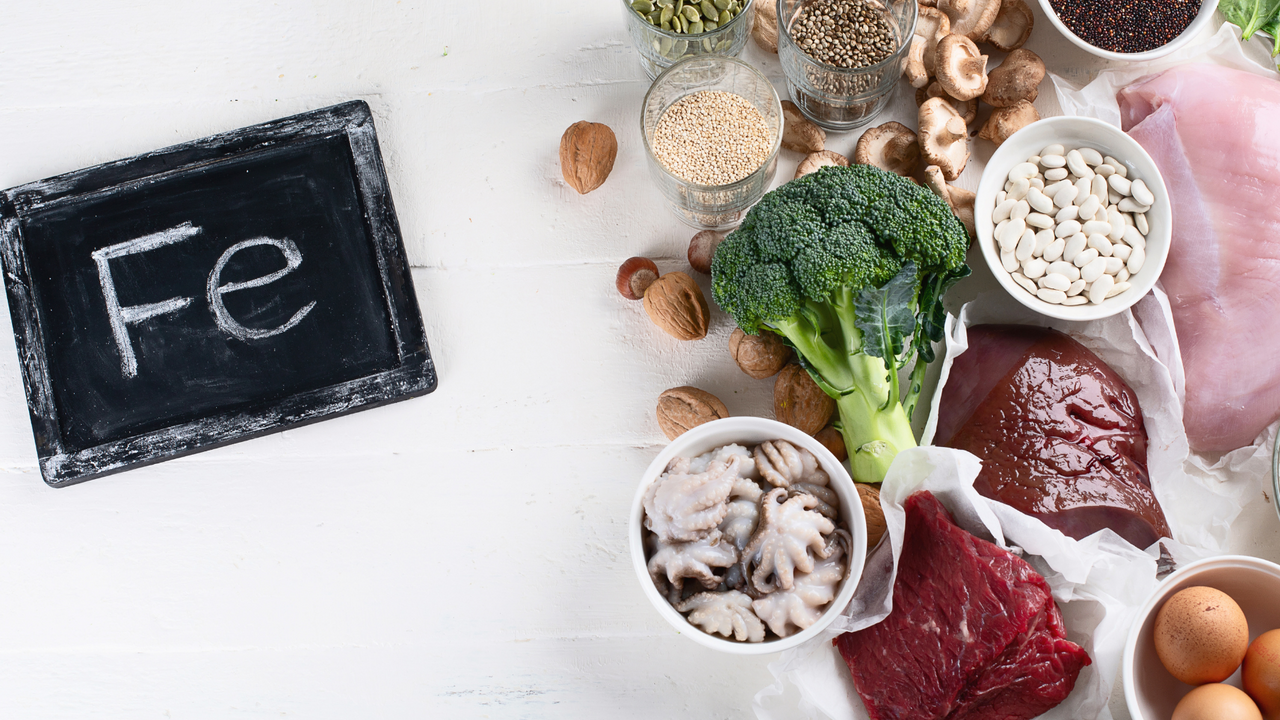
Iron is an essential mineral for human health, and a key component to a well-rounded dietary profile. Unfortunately, iron deficiency is also the most common deficiency in the world. For this reason, our team of Registered Dietitians often work closely with their clients to ensure appropriate intake, and to help educate on factors that can increase one's demand on iron, and hinder or help our body's absorption. In this article, we'll share:
- Why iron is important
- How to determine how much iron you require in your diet
- Who is at increased risk of deficiency
- The difference between heme vs. non-heme iron
- Strategies for optimizing iron absorption during meals and snacks!
You can also listen to our Podcast episode where we discuss iron by clicking here.
WHY IS IRON SO IMPORTANT?
As our Registered Dietitians in Saskatoon often share with their clients, adequate iron intake is important throughout varying phases of the lifecycle, primarily due to its essential role in blood production and oxygen transport. Beyond maintaining oxygen levels, iron also plays an important role in healthy immune functioning, energy metabolism, and respiration. Every cell in the body needs iron to produce energy. Let's explore some key roles of iron at different periods of the lifecycle:
- Pregnancy: Additional iron is needed to increase red blood cell mass and supply iron to the growing fetus
- Infancy and childhood: Iron is required for normal cognitive and psychomotor development
- Adulthood (and those at all ages!): Iron is involved in the formation of red blood cells, which work to deliver oxygen to the body’s tissues and systems. Without enough iron, individuals can tire easily and are unable to fight infections!
- Athletes: Iron is an essential component of red blood cells that carry oxygen to hard working muscles
Over your lifespan, your iron needs will change. The below table offers a general overview of daily recommended iron values.
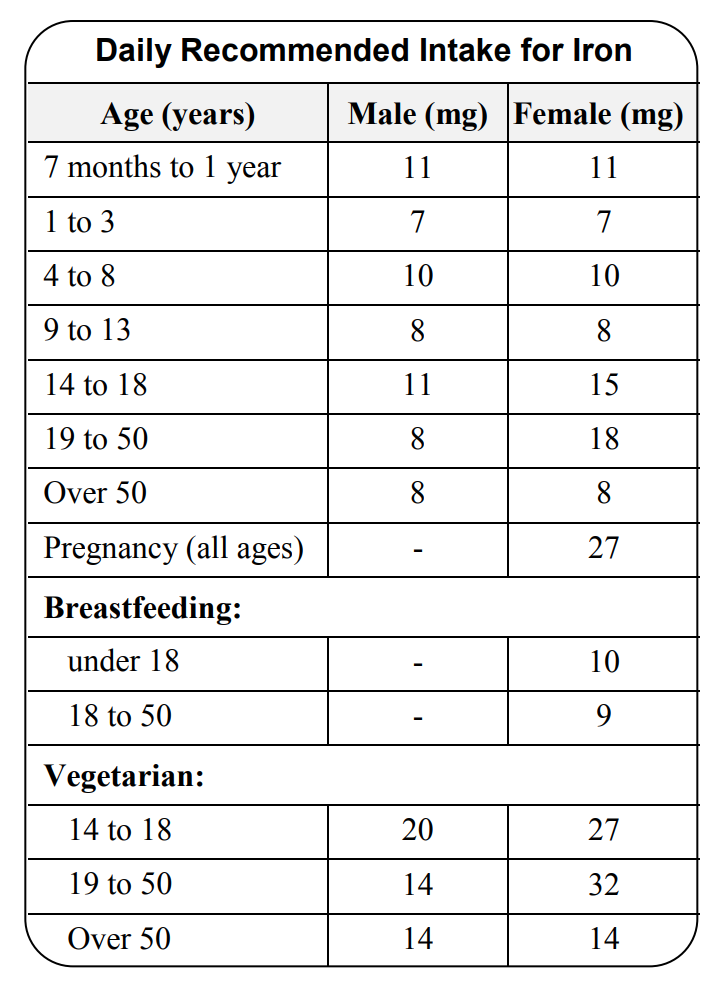
WHEN DO I NEED MORE IRON IN MY DIET?
Those who lack an appropriate level of iron are said to have an iron-deficiency. You may suspect an iron deficiency due to the symptoms or population risk-factors listed below, or have this diagnosis shared with you by a trusted medical professional such as a family doctor. Common symptoms of an iron-deficiency include dizziness, poor energy, a pale colour to the skin, and breathlessness as insufficient oxygen is being circulate to the cells of the body.
The main elements that cause iron deficiency are:
- Inadequate intake
- Poor absorption
- Increased iron losses
- Increased physiological demand for iron.
While every person needs iron in their diet, there are some populations who require more. These populations include:
- Pregnant women: During pregnancy, a woman’s blood volume increases to provide oxygen to her growing baby and reproductive organs. With increased blood volume comes an increased need for more iron. In addition to consuming iron-rich food sources, Health Canada recommends that pregnant women supplement with 16-20 mg of iron per day [14]. This is why most pre-natal vitamins contain iron!
- Infants & children: Infants and children require increased iron due to their rapid growth and development. Right before birth, babies receive a large transfer of iron from their mother that will last them approximately six months. After six months, babies will require iron from dietary sources to refill their stores. As Registered Dietitians, we teach parents how to safely introduce solids to their infants and to ensure that baby’s first foods contain the key nutrients needed to help them thrive. An important first food category for infants are highly absorbable iron-containing proteins such as meat, poultry, and fish. A few dietitian favourites are bison, beef, sardines, and moose meat!
- Menstruating women: Women need more iron than men to make up for the amount of iron they lose during their menstrual period [15]. Furthermore, women who experience heavy menstrual bleeding require even more iron to make up for the additional iron they lose. [16].
- Those engaging in high intensity exercise: Performing regular high intensity exercise has been found to increase an individual's iron requirements – particularly for females – by 30 to 70%, compared to those not exercising at this level.
- Endurance athletes: Running can cause red blood cells to break down at a faster rate (called ‘foot strike’), therefore requiring additional iron to make up for the losses. Recent research has also placed a strong focus on the role of exercise-induced inflammation in decreasing iron absorption [17]. This may be due to increasing the iron regulatory hormone (hepcidin) response which is known to result in decreased iron absorption. Lastly, endurance athletes also are known to produce more red blood cells relative to sedentary individuals which increases their iron requirements [18]. Those who participate in endurance sports are encouraged to work alongside a Registered Dietitian to help calculate heightened iron loss, and increase daily intake appropriately!
- Vegetarians and vegans: Since vegetarians and vegans do not consume heme iron in their diet (sourced solely from animal flesh), they may be at risk for having lower iron levels. Non-heme iron sources (ie., plant sources) can provide vegatarian-friendly iron sources, but may need to be consumed at a greater quantity (up to 1.8x more than heme iron) or be more intentionally consumed to ensure appropriate daily levels! Non-heme iron is better absorbed when paired with Vitamin C-rich foods, and when not paired with polyphenol-rich beverages (like black tea, coffee, or wine) or calcium-rich foods or supplements. Whether you're a new or seasoned vegetarian or vegan, working alongside a Registered Dietitian can help ensure you are consuming appropriate levels of iron using strategies that are in alignment with your larger dietary/lifestyle values.
- Other populations who may require more iron include:
- People who donate blood often
- People with decreased stomach acid
- People with digestive problems (e.g., celiac disease, inflammatory bowel disease), as these conditions can hinder absorption
- Those having received surgery or medications that impair stomach acid production, as these will also decrease iron absorption
- Post-menopausal women on hormone replacement therapy, which can cause uterine bleeding and increase iron losses
- Young children with an excessive intake of cow's milk which may displace iron-rich foods or effect iron absorption
- Adolescents who are experiencing a growth spurt
NOTE: By contrast, people with a condition called hereditary hemochromatosis can experience iron overload. In this case, the individual will need to work to keep their iron levels in the normal range by regularly donating blood, as well as limiting iron-rich foods and iron-containing supplements!
Iron deficiency occurs in stages, with iron deficiency anemia (IDA) as the last stage. IDA may be detected through blood work; ferritin, iron, and transferrin saturation values will be evaluated to diagnose IDA. If IDA is diagnosed, your physician will closely monitor these values moving forward. In this condition, the body’s iron stores are so low that not enough red blood cells can be produced to carry oxygen throughout the body efficiently. Symptoms of iron deficiency anemia include fatigue, weakness, dizziness, pale skin or fingernails, and headache. Our team of Registered Dietitians in Saskatoon often receive referrals from family physicians after a client is diagnosed with IDA, and work closely with these individuals to assist in long-term strategies to avoid ongoing low-levels of iron through diet and lifestyle techniques.
SOURCES OF IRON
In food, iron is found in two different forms: heme and non-heme iron.
- Heme iron is found only in animal products, including meat, poultry, and seafood. Some rich sources of heme iron include lean beef, bison, chicken, turkey, fish, and shellfish.
- Non-heme iron is found in plant foods. Some rich sources of non-heme iron include whole grains, legumes, nuts, seeds, dark leafy greens, and dark chocolate. In Canada, many breakfast cereals, pastas, and breads are fortified with non-heme iron.
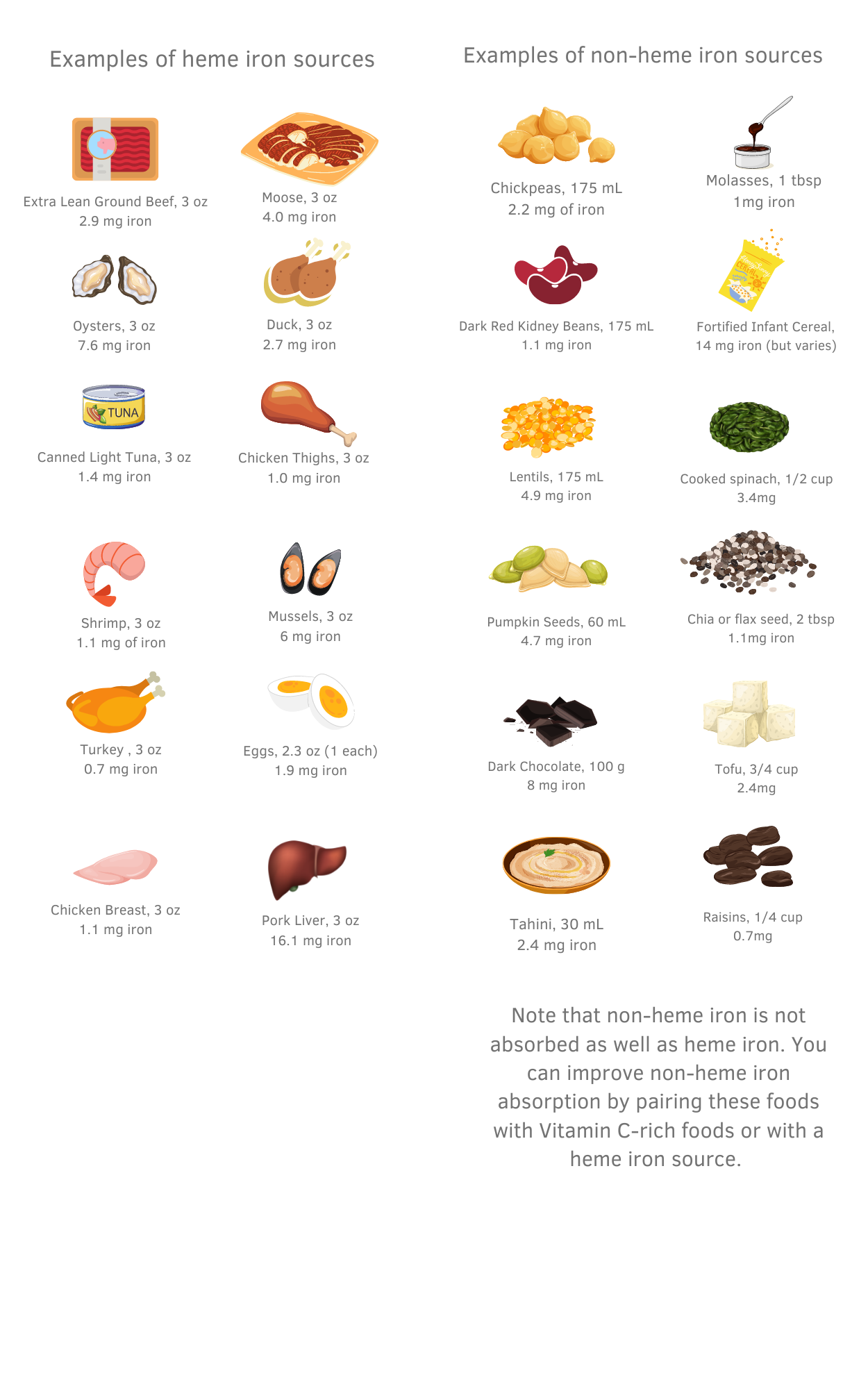
HOW TO CALCULATE THE AMOUNT OF IRON USING A FOOD LABEL
When looking at a nutrition facts label, you will see that many of the nutrient amounts are shown using percent daily value (% DV). This percentage can help us determine if there is a little or a lot of a nutrient in a serving size of our food product. If % DV is less than 5% there is a little, and if it is greater than 15% there is a lot.
It is important to note that in Canada, the % DV on all nutrition labels is calculated using 14 mg of iron as the set daily value [2]. If you would like to determine the amount of iron in milligrams, multiply the % DV by 14 mg. For example, the nutrition facts label below for 100 g of extra lean ground beef states 15% DV of iron per serving. This equates to 2.1 mg of iron per serving (0.15 x 14 mg = 2.1 mg).
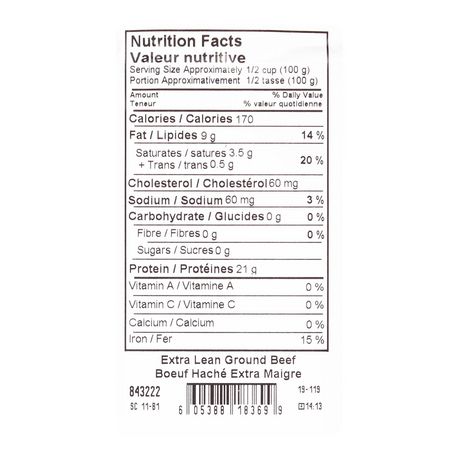
FACTORS THAT INFLUENCE IRON ABSORPTION
It's important to know that heme iron (animal-based form) is absorbed better than non-heme iron (plant-based form). While non-heme iron is less bioavailable, there are ways to enhance its absorption:
- Pair non-heme iron with heme-iron: The heme-iron found in animal based foods (eg., red meat) can enhance the absorption of non-heme iron found in plant-based sources (eg., lentils) [9]. By pairing heme sources with non-heme sources, you can increase the iron absorbed from the non-heme source. For example, using ground beef in a chili (heme iron) will enhance the absorption of iron from the beans (non-heme iron).
- Separate calcium-rich foods from your iron-rich meals: Calcium, whether from food or supplement source, has been shown to impair iron absorption [7]. To maximize iron absorption, our Registered Dietitians recommend that calcium-rich foods or supplements are consumed separately from iron-rich meals in order to get the most from your dietary iron. For example, drinking milk or calcium-fortified plant- based milk alongside your iron-rich chili will negatively impact the absorption of iron. In this case, you might enjoy your calcium-rich beverage at a different meal.
- Pair non-heme iron foods with a source of Vitamin C: Eating 100mg of Vitamin C-rich foods during a meal has been shown to improve non-heme iron absorption by 67% [10]. Without Vitamin C as an enhancer, only 2-20% of non-heme iron is absorbed [11]. Vitamin C-rich foods include, but are not limited to, dark green leafy vegetables, citrus fruits, bell peppers, tomatoes, berries, kiwis, and melons. Examples of such pairings include adding strawberries to your morning oatmeal or adding tomato sauce with ground beef to your whole wheat pasta.
- Limit tannin-containing drinks: Drinks such as black tea, coffee, and wine contain tannins, which can prevent the absorption of non-heme iron. Enjoying these beverages between meals (an hour before or after) as opposed to with meals can help ensure maximum non-heme iron absorption.
- Soak foods that contain phytates: Foods containing phytates (such as vegetables, legumes, grains, nuts, and seeds) can also hinder iron absorption. Pairing non-heme iron sources that contain phytates with Vitamin C is one way to enhance the absorption of the phytate-containing iron source. You can further enhance iron absorption in the presence of phytates by soaking or sprouting nuts, seeds, and legumes. For example, soaking your beans before cooking them removes some of the iron-binding phytates. Purchasing sprouted grain breads or oats may also enhance the absorption of non-heme iron!
Other factors that can decrease iron absorption is vegetable protein (independent of that food's phytate content) and taking supplements with large doses of zinc, manganese, or copper as these can compete with iron binding sites. Another way to enhance iron intake is to cook with cast-iron, as some iron from the cookware is transferred to the food itself.
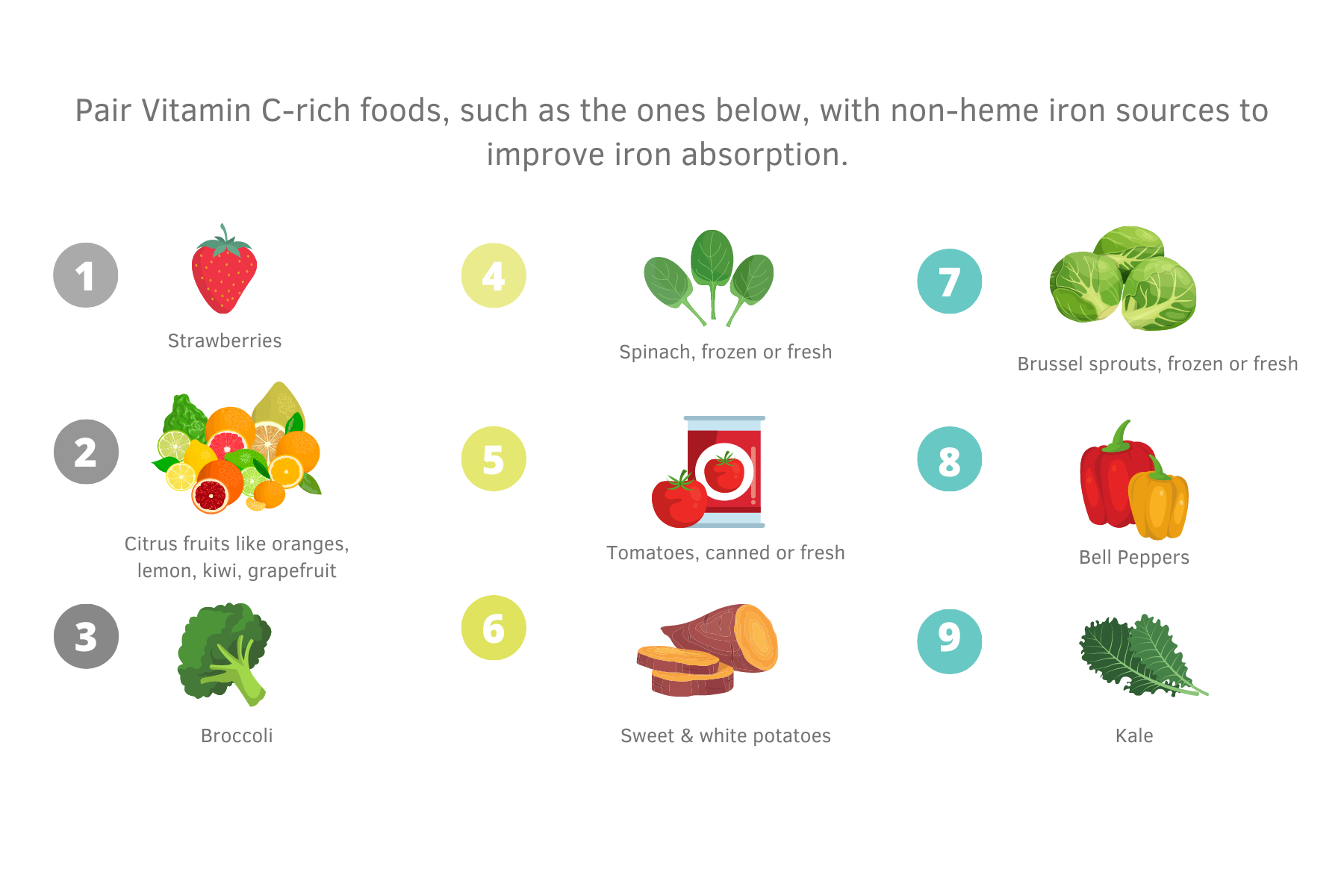
IRON SUPPLEMENTS
Iron supplements are not for everyone. While iron supplements may be helpful among people who require more iron, it is important to note that taking these supplements unnecessarily may result in negative effects. Such effects include digestive changes (e.g., constipation) and a reduced absorption rate of other important nutrients such as zinc and magnesium. In contrast to health promoting anti-oxidants discussed in our article on reducing inflammation, excess iron can have pro-oxidant effects within the body, meaning that it can cause oxidative stress (i.e., cellular damage).
If you have concerns regarding your iron status, speak with your physician about formally assessing this data via blood work. If needed, your healthcare provider will help determine the appropriate form of treatment, which may include making changes to your diet and/or taking a supplement. As Registered Dietitians, we can help you navigate these new changes and work to optimize the amount and types of iron in your diet.
MEAL & SNACK IDEAS
If you are looking for ways to boost your intake and absorption of iron, check out our iron-rich meal and snack recipes below! You'll notice that many of these dietitian-designed recipes pair non-heme iron with a source of vitamin C to maximize absorption.
MEAL IDEAS:
- Darian's Meat Sauce
- Mediterranean Turkey Burgers
- Freezer-Friendly Breakfast Burritos
- Spaghetti Squash Bake
- One-Pot Mexican Skillet
SNACK IDEAS:
- Beef jerky with cherry tomatoes or an orange
- Oysters with a high fibre cracker and cream cheese
- Almonds with an orange
- Hummus with broccoli
- A hardboiled egg with an apple
- Dark chocolate with strawberries
- Roasted lentils or chickpeas with bell peppers
- An Oatmeal Gold bar with strawberries
- Sardines with whole grain crackers

REGISTERED DIETITIANS ARE HERE TO HELP!
As we hope this article has helped you understand, iron is a fundamental mineral in supporting human health. As with many important minerals, consumption- and absorption-rates can be more complicated than they first appears. Iron needs can be impacted by different stages of life, lifestyle factors, and dietary patterns. Absorption can also be impacted by various medical conditions, activity levels, and the types of dietary sources we consume. For all of these reasons, working alongside a Registered Dietitian can take out the guess work, and bring an evidence-based, effective strategy for long-term success! The team at Vitality Nutrition in Saskatoon encourages you to take iron seriously, and reach out to either a family physician or a local dietitian for professional guidance as needed.
Ready to bring the evidence-based nutrition support of our Registered Dietitians into your kitchen?
Hungry for more?
Get recipes, tips, and updates from the Vitality Nutrition team straight to your inbox!
Don't worry, your information won't be shared.

